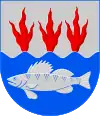Kuortane
It is located in the South Ostrobothnia region. The municipality has a population of 3,542 (31 July 2020)[2] and covers an area of 484.88 square kilometres (187.21 sq mi) of which 22.72 km2 (8.77 sq mi) is water.[1] The population density is 7.66 inhabitants per square kilometre (19.8/sq mi).

Kuortane | |
|---|---|
Municipality | |
| Kuortaneen kunta Kuortane kommun | |
 Coat of arms | |
 Location of Kuortane in Finland | |
| Coordinates: 62°48.5′N 023°30.5′E | |
| Country | |
| Region | South Ostrobothnia |
| Sub-region | Kuusiokunnat sub-region |
| Government | |
| • Municipal manager | Pentti Turunen |
| Area (2018-01-01)[1] | |
| • Total | 484.88 km2 (187.21 sq mi) |
| • Land | 462.17 km2 (178.44 sq mi) |
| • Water | 22.72 km2 (8.77 sq mi) |
| Area rank | 189th largest in Finland |
| Population (2020-07-31)[2] | |
| • Total | 3,542 |
| • Rank | 205th largest in Finland |
| • Density | 7.66/km2 (19.8/sq mi) |
| Population by native language | |
| • Finnish | 99.4% (official) |
| • Swedish | 0.1% |
| • Others | 0.5% |
| Population by age | |
| • 0 to 14 | 15.3% |
| • 15 to 64 | 59.5% |
| • 65 or older | 25.2% |
| Time zone | UTC+02:00 (EET) |
| • Summer (DST) | UTC+03:00 (EEST) |
| Municipal tax rate[5] | 19.5% |
| Website | www.kuortane.fi |
Kuortane is a municipality of Finland.
The municipality is unilingually Finnish.
Kuortane is the birthplace of world-famous architect Alvar Aalto.
Kuortane has a notable history of pine tar production. It is currently well known for the Kuortaneen urheilulukio, a sports institute and training facility where many young Finnish athletes study and train. Both the women's national under-18 ice hockey team and Team Kuortane of the Naisten Liiga are based at the institute.
People
- Alvar Aalto (1898–1976), architect and designer
- Osmo Ala-Honkola (born 1939), Olympic sport shooter
- Reino Ala-Kulju (1898–1983), Lutheran clergyman, politician, and teacher
- Mira Suhonen (born 1985), Olympic sport shooter
See also
References
- "Area of Finnish Municipalities 1.1.2018" (PDF). National Land Survey of Finland. Retrieved 30 January 2018.
- "Suomen virallinen tilasto (SVT): Väestön ennakkotilasto [verkkojulkaisu]. Heinäkuu 2020" (in Finnish). Statistics Finland. Retrieved 13 September 2020.
- "Population according to language and the number of foreigners and land area km2 by area as of 31 December 2008". Statistics Finland's PX-Web databases. Statistics Finland. Retrieved 29 March 2009.
- "Population according to age and gender by area as of 31 December 2008". Statistics Finland's PX-Web databases. Statistics Finland. Retrieved 28 April 2009.
- "List of municipal and parish tax rates in 2011". Tax Administration of Finland. 29 November 2010. Retrieved 13 March 2011.
External links
 Media related to Kuortane at Wikimedia Commons
Media related to Kuortane at Wikimedia Commons- Municipality of Kuortane – Official website (in Finnish)

